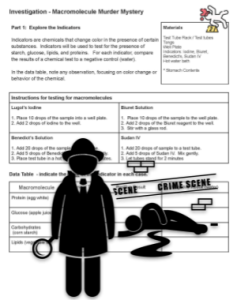
If you’re looking for a creative and engaging way to teach biological macromolecules, look no further than this murder mystery lab activity. Students become forensic scientists, analyzing evidence to solve a crime. Using Lugol’s iodine, Biuret solution, Benedict’s solution, and Sudan IV, students will identify macromolecules in the contents of a victim’s stomach and match their findings to meals from local restaurants to crack the case.
Students will explore how different indicators react with carbohydrates, proteins, and lipids. Lugol’s iodine identifies starch, Biuret solution detects protein, Benedict’s solution reveals simple sugars, and Sudan IV highlights lipids.
With results in hand, students will compare their findings to the macromolecule profiles of menu items from the three restaurants. Which meal—and which restaurant—matches the evidence? The murder mystery storyline hooks students from the start, turning a standard lab into a compelling investigation.
The Story: Setting the Scene
A victim has been found under mysterious circumstances, and the key to solving the case lies in their last meal. The stomach contents hold vital clues that can lead investigators to the restaurant the victim visited and what they ate. Three restaurants are under investigation, each with distinct menu items containing different macromolecule profiles.
In small groups, students will test a mock stomach content sample using the four indicators. Each test reveals the presence or absence of specific macromolecules, offering clues about what the victim ate.
Once you have determined which macromolecules are present in the stomach, you can determine where the victim had his last meal.
Materials Needed
Stomach Contents – prepared in advance
Test tubes and well plates for testing materials
Lugol’s Iodine – starch test
Biuret Solution – protein test
Benedict’s Solution – sugar test
Sudan IV – fat test
Related Resources
Chicago Cyanide Murders – investigate how cyanide interferes with the mitochondria and the role of oxygen in cellular respiration
Macromolecules – The Building Blocks of Life – explore how elephants and lions use macromolecules to grow and maintain homeostasis
Macromolecules – Testing for Starch – a simpler activity for beginning biology students to test different solutions
McMush Lab – testing for macromolecules in a Happy Meal
Presentation Slides on the Chemistry of Life with student notes

